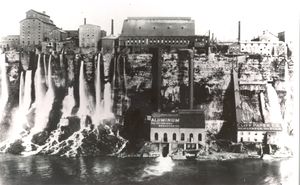Electrolytic Reduction of Aluminum
In 1886, Charles M. Hall and Paul-Louis-Toussaint Héroult, working separately, but at the same time, both discovered that alumina and electricity can make aluminum economically.
On one side of the Atlantic Ocean, in the town of Oberlin, Ohio, Charles Martin Hall, a college student and minister’s son, began working with chemistry professor Frank F. Jewett on experiments in aluminum. Jewett, trained in chemistry at Yale University and the University of Gottingen, had taught science at the Imperial University of Tokyo and joined Oberlin’s faculty in 1880 at the age of thirty-six. Jewett had become versed in the potential for aluminum science during his years abroad and introduced Hall to the field.
Like many of their contemporaries in chemistry during the Gilded Age, Jewett and Hall believed that unlocking the technique for pulling aluminum out of its oxide ore would lead to great fortune. Aluminum was abundant in nature but it was very expensive to extract and refine: its cost was comparable to silver before 1886.
Initially, Jewett and Hall tried applying chemicals to aluminum ore to turn it into metal, but these attempts failed. Next, they used electrical current to trigger the process. This method was promising, but they had difficulty generating enough power to produce aluminum. Jewett and Hall built a battery using Bunsen Grove cells made of zinc electrodes. It took a pound of hand-cast zinc electrodes to generate the power needed to make just an ounce of aluminum.
During his last year in college and after his graduation, Hall experimented with different chemical solvents in an effort to find the right solution for refining aluminum oxide. His sister, Julia, who had also studied chemistry at Oberlin, joined his laboratory, which he built in a woodshed behind his parents’ home.
His first idea was to pass electrical current through a solution of aluminum fluoride, which only ended up producing hydrogen gas and aluminum hydroxide. His next plan was to use molten fluoride salts, which improved on the old method because they did not absorb water from the air. To get the fluoride salts sufficiently hot, he switched from a coal-fired furnace to a gasoline-fired stove. Yet even at a high temperature, the fluoride salts did not produce very much aluminum out of the aluminum oxide.
Finally, in February, 1886, Hall set on the idea of using a solution of cryolite (sodium aluminum fluoride) to dissolve the aluminum oxide at the extremely high temperature of 1000 degrees celcius. Realizing that his clay crucible was producing silicon deposits in reaction to the chemical and the high heat, he lined it with graphite and lowered the melting point through the addition of aluminum fluoride. On February 23, 1886, he tested this new protocol, applying electrical current for a few hours to the hot cryolite solution. When it cooled, he opened the metal and discovered it contained small amounts of aluminum. He applied for a patent on this process on July 9, 1886.
At the same time, in Paris, Héroult was experimenting with the use of cryolite to dissolve aluminum oxide. Like Hall, Héroult became fascinated with aluminum in college and performed his successful experiments when he was barely into his twenties. He won a French patent on April 23, 1886, and applied for an American patent in May. But Hall’s family had observed his experiments and testified that he had made his discovery in February, and the United States patent office awarded Hall, not Héroult, the rights to the process.
Just two years later, Hall and a group of investors founded the Pittsburgh Reduction Company to commercialize electrolysis. Their company, now known as the Aluminum Company of America (Alcoa, Inc.), rapidly drove down the cost of making aluminum and developed new markets for the product. Soon, aluminum would be present in everything from consumer goods to electrical transmission lines to aircraft.
